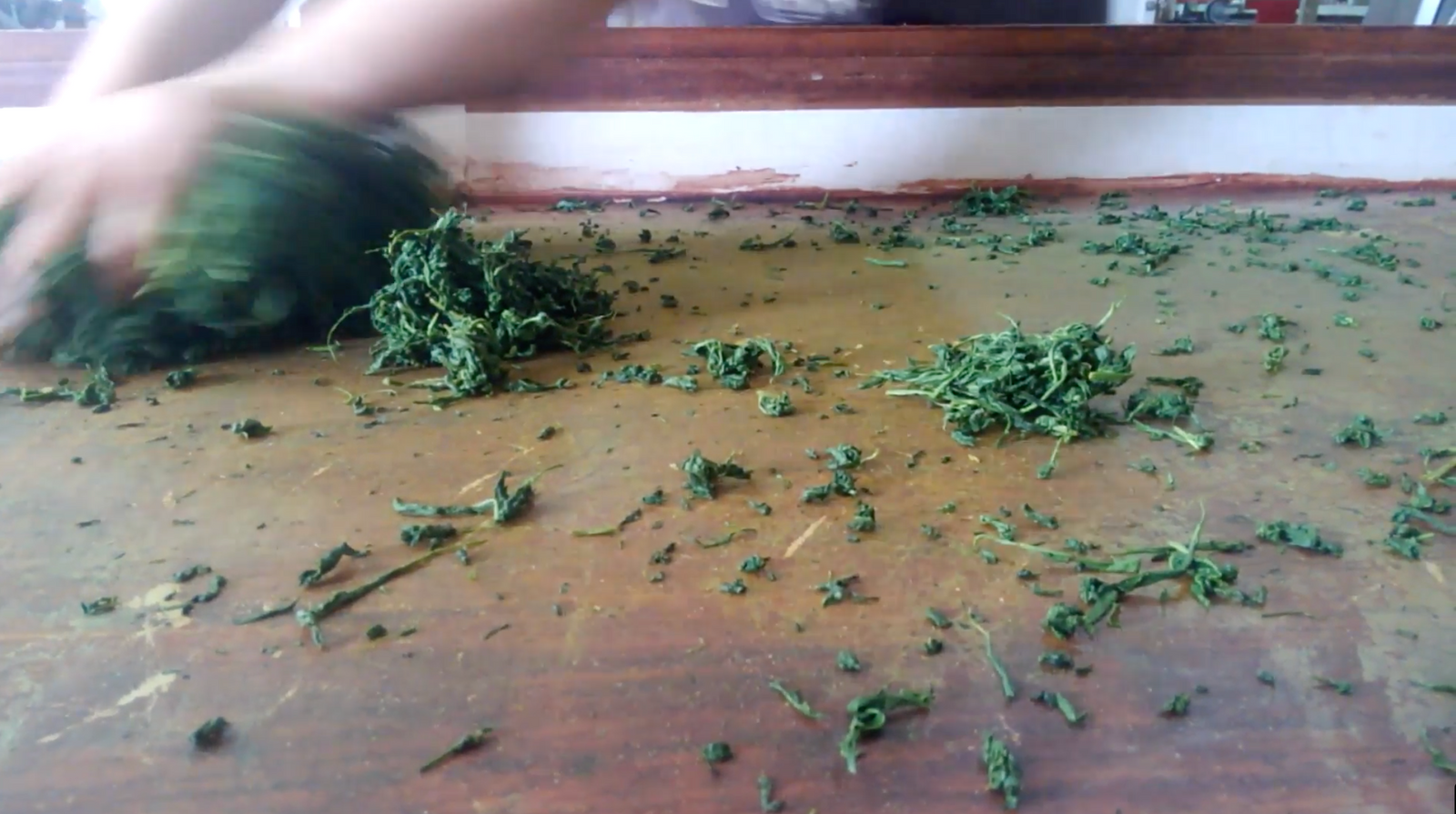先日、鹿児島県霧島市牧園町近郊にある茶園「幸喜園茶園」を訪問する機会がありました。ここは、米や椎茸など、一年を通して農業を営む家族経営の茶園です。中でも、有機栽培の日本茶(緑茶、ほうじ茶、紅茶)の栽培と加工は、彼らの重要な仕事の一つです。一番年下の川口ゆりえさんと茜さんの姉妹が、3月中旬に私たちを茶畑と工場へ親切に迎え入れてくれました。
 川口ゆりえさんと茜さんが、ご家族で営む茶工場を案内してくれました。これから1ヶ月ほど、お茶の収穫と加工で大忙しで、休む暇もないほどだそうです!
川口ゆりえさんと茜さんが、ご家族で営む茶工場を案内してくれました。これから1ヶ月ほど、お茶の収穫と加工で大忙しで、休む暇もないほどだそうです!
姉妹の一人、茜さんは静岡県で修行中に習得した手揉みの技術を習得しています。彼女は自身の経験に触れながら、製茶工場内の様々な機械を見学しながら、煎茶の製造に使われる一般的な機械が手揉みの工程を模倣していることを指摘してくれたので、私はその工程にさらに興味をそそられました。さて、今日は新茶の季節が間近に迫っているので、煎茶の手揉み(日本語:手揉み)の工程について少しお話したいと思います。
 幸喜園の川口あかねさんが、茶工場の機械が手揉みの工程を模倣している様子を説明しています。
幸喜園の川口あかねさんが、茶工場の機械が手揉みの工程を模倣している様子を説明しています。
ご存知の方も多いと思いますが、現在ではごく稀な競技用煎茶を除き、機械揉み工程で加工されています。針のように細く美しく伸ばされた手揉み茶は、まさに芸術作品!芸術的な見た目に加え、機械による過度な力を加えないことで、茶葉本来の形状を保つことができます。そのため、手揉み茶を湯に浸した際に、摘み取った当初の茶葉の形状をはっきりと見分けることができます。しかし、お茶の手揉み工程は、 300gの完成乾燥茶を作るのに約6~7時間(様々な要因により変動)の連続揉みを要します。熟練の職人でも300gの茶葉しか作ることができません。これは、1.5kgの生茶葉を手揉みできるのが限界だからです。この大変な作業を自動化するために、機械揉み工程が始まりました。
手揉み茶の歴史を少し紐解くと、その始まりは1738年、京都府宇治田原地方の茶農家、永谷宗円(1681~1778)に遡ります。宗円は、日本茶( 煎茶)特有の製法を考案・標準化したため、「日本の煎茶の父」とされています。詳しく言うと、宗円は約15年間製法を試行錯誤した後、摘み取ったばかりの茶葉を蒸し、低温の炭火を焚いた焙炉台の上で熟練の手揉みによって揉み上げる製法を考案した人物です。 ( ※焙炉台とは、和紙を張った丈夫な台です。)
永谷宗円の発見以前は、茶葉を蒸すか煮る工程を経て、焙煎または天日干し( 美作番茶や寒茶などの多くの伝統的な番茶に施されている方法)で乾燥させていました。これにより茶葉は茶色っぽくなってしまいます。これに対し、永谷の新しい製法は、爽やかな緑色、香り、風味を持つ煎茶を生み出したため、革命的だと考えられていました。手揉みの工程は、茶葉をほぐす、揉む、こねる、揉むという作業を組み合わせたものです。この職人技の工程は動画で見て理解するのが一番良いかもしれませんが、以下に主な工程と、各工程にかかる時間を概説します。工程は簡略化されていますが、実際に茶葉を手揉みする技術には細かな詳細があることにご注意ください。*各工程の後に、括弧内に各工程の日本語名も記載しています。
日本茶を手揉みする手順
- 葉ぶるい:蒸した新茶の葉を胸の高さからほうろ台に落とし、露を吹き飛ばします(60分)。
- 軽回転 :茶葉を転がして中心部の水分を取り除き、乾燥させます(40分)。
- Heavy Rotation (重回転 / jyu-kaiten) :回転プロセス (20 分間) で熱を減らし、より多くの重量/力を加えます。
- 中上げ:茶葉をほぐして取り出し、焙炉台を清掃します(15分)。
- もみきり:両手でお茶を持ち、前後に動かしながら円を描くように揉みます。最初は力を入れずに茶葉を散らしますが、茶葉が乾いてきたら、力を入れてより丁寧に揉み込みます(60分)。
- でんぐり:茶束を持ち、左右に回しながら伸ばす(30分)
- こくり:同じ方向にお茶を揉み、光沢のある繊細な針のような形に成形します(60〜90分)。
- 乾燥(かんそう):茶葉は、中央に穴を開けた竪台の上に、きれいに均一に広げられます。温度を約60℃に保ち、乾燥させて揉み工程を完了します(90~120分)。
 手揉み茶の技術を完成させる最後の工程です!
手揉み茶の技術を完成させる最後の工程です!
手巻きの伝統を守る
今では貴重な手揉み茶であり、この技術と伝統を守るため、毎年全国手揉み茶芸競技会が開催されています。競技会なので、誰が最も高品質な手揉み茶を作ることができるかが勝負です!世界的なパンデミックの影響で、この競技会は2020年と2021年の2年連続で中止となりました。しかし、2年間の休止を経て、昨年11月に静岡県藤枝市で再開されました。実際、昨年は幸喜園の川口あかねさんチームが、参加した26チーム中4位に輝きました。競技会にどれくらいの時間がかかるのか気になっている方もいるかもしれません。今回は、参加者が新鮮な茶葉を細い針のような形に手で揉むのに約5時間かかりました。そしてもちろん、審査員が茶葉の外観だけでなく、手揉み茶の乾き具合、香り、そして味までを審査する審査プロセスがあります。手揉み茶に興味があるなら、このイベントはぜひチェックしてみてください!最後に、手揉み茶を体験してみたい方は、Yunomiでいくつか選択肢があります。例えば、 伝説の茶揉み師、隅田吉郎氏によるものなどです。
 2022年11月に開催された全国手揉み茶道大会にて、中央にいるのは川口あかねさん(幸喜園)。あかねさんは、手揉み茶道の体験を多くの人に伝えたいと語り、過去の参加者のサインが入った焙炉台の裏を見せてくれました。いつか焙炉台の裏をいっぱいにするのが彼女の夢だそうです!
2022年11月に開催された全国手揉み茶道大会にて、中央にいるのは川口あかねさん(幸喜園)。あかねさんは、手揉み茶道の体験を多くの人に伝えたいと語り、過去の参加者のサインが入った焙炉台の裏を見せてくれました。いつか焙炉台の裏をいっぱいにするのが彼女の夢だそうです!
お茶の手揉み工程の写真はすべて、幸喜園茶園よりご提供いただきました。近日中に幸喜園茶園のお茶、そしてもちろん湯呑みコレクションのお茶についてもご紹介させていただきますので、どうぞお楽しみに。またね!
 幸喜園の茶畑では新茶の季節に向けて新芽が芽吹き始めました!
幸喜園の茶畑では新茶の季節に向けて新芽が芽吹き始めました!



1件のコメント
I was a member of Fujieda-shi Cha Temomi Hozonkai for three years and can attest to how incredibly strenuous the hand-rolling process can be. It’s really exciting to see some younger Japanese folks picking up the tradition and carrying it to other parts of the country! Thanks for presenting such a good temomi-cha overview in English.